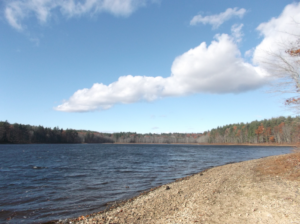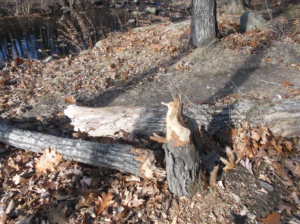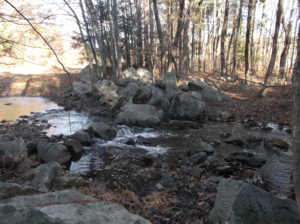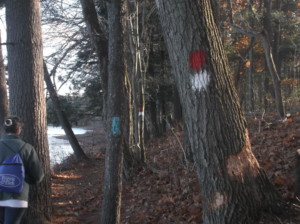Earlier this week I signed up by email for a “Mystery Meander” and was instructed to meet in the parking lot of the Buffumville Lake boat ramp, off Oxford Street in Charlton, which is about a half hour drive from my home. At 1 pm, I joined four adult humans and two dogs, for a two hour walk around the lake. Last Green Valley Lead Ranger Marcy led the way along the 3 mile North Loop trail.
After my trip to Arizona this past summer, I realized that land ownership patterns can be quite different in various parts of the country. Whereas out west the Federal government owns huge tracts of land, in our state, most of the land is in private hands. I became curious about the land ownership question, so I tried to find some numbers for Massachusetts and the rest of the country. Although these percentages are old, they probably hold true, proportionately, today: Massachusetts ranks 39th out of 50, in terms of percent of land in public hands. For state land ownership, I came up with three numbers from the Mass Audubon website, but it’s not totally clear in my mind what they represent: the state owns and protects 650,000 acres of conservation land; DCR manages 450,000 of these acres as our state parks, urban parks, and public watersheds; the Massachusetts State Parks system encompasses over 300,000 acres and is the ninth largest park system in the nation. Here are some numbers I found for Federal land:
- Total acreage of Mass: 5,034,880
- Total federal land acreage: 81,692
- Federal land percentage of Mass: 1.6%
I don’t have a finer breakdown of the types of federal land, and it could be that a majority of those 80,000 plus acres are national park land, such as land protected at the Cape Cod National Seashore. Where I was today, Buffumville Lake, is a much smaller pocket of public land: 500 acres of land and 200 acres of water in southern Worcester Country, which “the U.S. Army Corps of Engineers manages . . . for multiple uses: flood control, wildlife habitat, forest production, watershed protection, and outdoor recreation.” If you are interested in delving deeper into this topic, you might be interested in this Congressional Research Service report on Federal land ownership.
The early afternoon sun shone brightly but the wind blew insistently, often roaring in our ears. As we strolled along the beach, deserted at this time of year, we shielded our faces from the blowing sand. Due to the season, I wasn’t expecting much in the way of wildlife sightings, but we did make some interesting observations:
- The hemlocks don’t appear to be infected with the woolly adelgid
- A large bird and other animals left tracks on the beach
- Mussel shells were abundant in the shore detritus
- Bufflehead ducks were out and about
- A beaver swam away from us when we approached the lodge
Marcy showed us how to make an acorn whistle from the cap of an acorn — I had to practice though, and I’m not very good at it. Here’s a feeble attempt I recorded at home:
Here’s a photo of the lake — we are looking toward the northwest:

Note the pencil-shaped tip of this gnawed off tree — it’s a sure sign of beavers:

Due to the persistent drought, water levels in the lake are low, but there are perennial brooks:

We followed the blue-blazed trail; here another trail blazed in red-white intersects with ours:

It seemed an appropriate sign for this pleasant Veterans Day ramble!